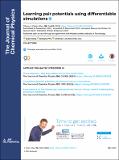Learning pair potentials using differentiable simulations
Author(s)
Wang, Wujie; Wu, Zhenghao; Dietschreit, Johannes CB; Gómez-Bombarelli, Rafael
DownloadPublished version (16.17Mb)
Publisher with Creative Commons License
Publisher with Creative Commons License
Creative Commons Attribution
Terms of use
Metadata
Show full item recordAbstract
<jats:p> Learning pair interactions from experimental or simulation data is of great interest for molecular simulations. We propose a general stochastic method for learning pair interactions from data using differentiable simulations (DiffSim). DiffSim defines a loss function based on structural observables, such as the radial distribution function, through molecular dynamics (MD) simulations. The interaction potentials are then learned directly by stochastic gradient descent, using backpropagation to calculate the gradient of the structural loss metric with respect to the interaction potential through the MD simulation. This gradient-based method is flexible and can be configured to simulate and optimize multiple systems simultaneously. For example, it is possible to simultaneously learn potentials for different temperatures or for different compositions. We demonstrate the approach by recovering simple pair potentials, such as Lennard-Jones systems, from radial distribution functions. We find that DiffSim can be used to probe a wider functional space of pair potentials compared with traditional methods like iterative Boltzmann inversion. We show that our methods can be used to simultaneously fit potentials for simulations at different compositions and temperatures to improve the transferability of the learned potentials. </jats:p>
Date issued
2023-01-28Department
Massachusetts Institute of Technology. Department of Materials Science and EngineeringJournal
The Journal of Chemical Physics
Publisher
AIP Publishing
Citation
Wang, Wujie, Wu, Zhenghao, Dietschreit, Johannes CB and Gómez-Bombarelli, Rafael. 2023. "Learning pair potentials using differentiable simulations." The Journal of Chemical Physics, 158 (4).
Version: Final published version